UNIT 3
Fundamental of soil and its classification
Q1) Explain Foundation?
A1) Foundation
The lowest part of a structure which transmits the weight of the structure together with live loads, seismic and wind pressure to the ground surface on which the structure rests, ensuring its safe bearing capacity, is called foundation. To increase the stability of the structure, foundations are generally placed below the ground level.
The selection of the foundation type for a particular site depends on the following considerations:
1. Nature of subsoil.
2. Nature and extent of difficulties
3. Availability of expertise and equipment
Depending upon their nature and depth, foundations have been categorized as follows
Q2) Explain Functions of Foundation?
A2)
Foundations distribute the loads of the super-structure, to a larger area so that the intensity of the load at its base (i.e. total load divided by the total area) does not exceed the safe bearing capacity of the sub-soil. In the case of deep foundations, it transmits the super-imposed loads to the sub-soil both through side friction as well as through end bearing.
2. Even distribution of load
Foundations distribute the non uniform load of the super-structure evenly to be sub-soil. For example, two columns carrying unequal loads can have a combined footing which may transmit the load to sub-soil evenly with uniform soil pressure. Due lo this, unequal or differential settlements are minimised.
3. Provision of level surface
Foundations provide levelled and hard surface over which the super-structure can be built.
4. Lateral stability
It anchors the super-structure to the ground, thus imparting lateral stability to the super-structure. The stability of the building, against sliding and overturning, due to horizontal forces (such as wind, earthquake etc.) is increased due to foundations.
5. Safety against undermining
It provides the structural safety against undermining or scouring due to burrowing animals and flood water.
6. Protection against soil movements
Special foundation measures prevents or minimises the distress (or cracks) in the super-structure, due to expansion or contraction of the sub-soil because of moisture movement .
Q3) Explain Types of shallow and deep foundations with neat sketches?
A3) Types of Shallow and Deep Foundations
Depending upon their nature and depth, foundations have been categorized as follows
(i) Open foundations or shallow foundations
(ii) Deep foundations
SHALLOW FOUNDATIONS
This is the most common type of foundation and can be laid using open excavation by allowing natural slopes on both sides. This type of foundation is practicable for a depth up to 5m and is normally convenient above the water table. The base of the structure is enlarged or spread to provide individual support. Since spread foundations are constructed in open excavations, therefore they are termed as open foundations.
The various types of spread footings are:
1.Wall footings
2.Isolated footings
3.Combined footings
4.Inverted arch footings
5.Continuous footings
6.Cantilever footing
7.Grillage footing
1. Wall Footings:
These footings can either be simple or stepped. The base course of these footings can be concrete or of entirely one material. They have only one projection beyond the width of the wall on either side. The width of the concrete base should be at least equal to twice the width of the wall. The depth of the concrete bed is at least equal to the projection. Generally the projection provided in the footing is 15cm, on either side and the concrete mix comprises of cement, sand and aggregate in proportion of 1:3:6 or 1:4:8.

2. Isolated or Column Footings:
They are used to support individual columns. In case of heavy loaded columns, steel reinforcements is provided. Generally, 15cm offset is provided on all sides of concrete bed. The footing of concrete columns may be slab, stepped or sloped type.
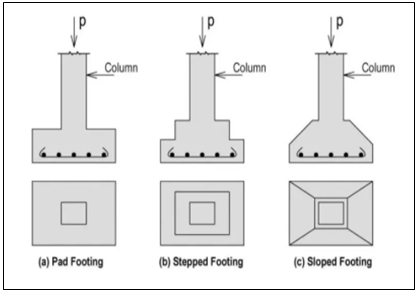
3. Combined Footings:
A combined footing supports two or more columns in a row. The combined footing can be rectangular in shape if both the columns carry equal loads or can be trapezoidal if both the loads are unequal. Generally they are constructed of reinforced concrete. The location of the center of the gravity of the column loads and centroid of the footing should coincide.
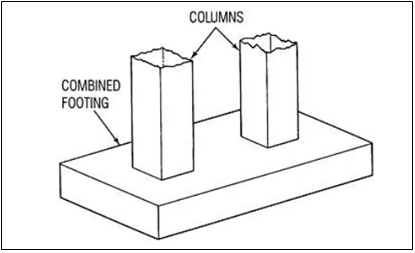
4. Inverted arch footing:
This type of footing is used on soft soils to reduce the depth of the foundation. Loads above an opening are transmitted from supporting walls through inverted arches to the soil. In this type of footings the end columns must be stable enough to resist the outward pressure caused by the arch action.
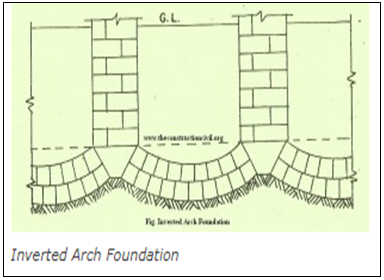
5. Continuous footings:
In this type of footing a single continuous R.C. slab is provided as foundation of two or three or more columns in a row. This type of footing is suitable at locations liable to earthquake activities. This also prevents differential settlements in structures.
6. Strap or cantilever footings:
Strap footing consists of two or more individual footings connected by a beam called strap. This type of footing is used where the distance between the columns is so great that the trapezoidal footing becomes quite narrow with bending moments.
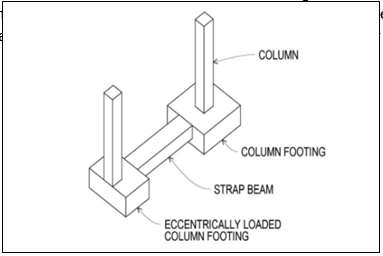
7. Grillage footings:
This type of footings is used to transmit heavy loads from steel columns to the soils having low bearing power. This type of arrangements prevents deep excavations and provides necessary area at base to reduce the intensity of the pressure.
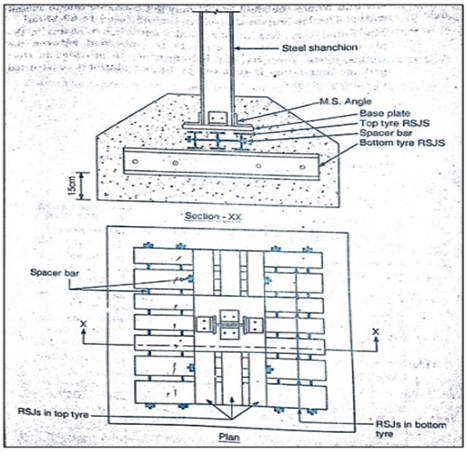
DEEP FOUNDATIONS
These foundations carry loads from a structure through weak incompressible soils or fills on to the stronger and less compressible soils or rocks at depth. These foundations are in general used as basements, buoyancy rafts, caissons, cylinders, shaft and piles
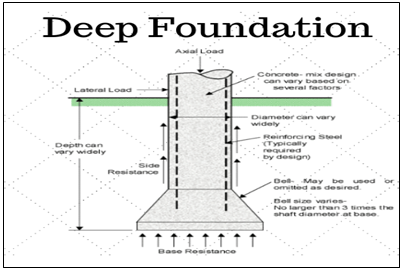
They are constructed in place in an open excavations. They are hollow substructures designed to provide working space below ground level.
2. Buoyancy Rafts
They are hollow substructures designed to provide a buoyant substructure beneath which reduce net loadings on the soil to the desired low density.
3.Caissons
They are hollow s8ubstructures designed to be constructed on or near the surface and then sunk as single units to their required level.
4.Cylinders
They are single small cell caissons.
5.Shaft Foundations
They are constructed within deep excavation supported by lining constructed in place and subsequently filled with concrete.
6.Pile Foundations
The pile foundation is a construction supported on piles. A pile is an element of construction composed of timber, concrete or steel or a combination of them. The piles may be placed separately or they may be placed in form of a cluster throughout the structure.
Q4) Explain Fundamentals of Irrigation Engineering?
A4) Irrigation is defined as the process of artificial supply of water to soil for raising crops. It is a science of planning and designing an efficient, low-cost, economic irrigation system tailored to fit natural conditions. It is the engineering of controlling and harnessing the various natural sources of water, by constructing dams and reservoirs, canals and head works, and finally distributing the water to the agricultural fields. Irrigation engineering includes the study and design of works in connection with river control, drainage of waterlogged areas and generation of hydroelectric power. India is basically an agricultural country and all its resources depend on the agricultural
Q5) Explain canals?
A5) A canal conveying water from the head works has to run for large distances and has to maintain the water levels appropriately, as designed along its length. It has to run through terrains which generally would have a different slope small than the canal. The surrounding areas would invariably have its own drainage system ranging from small streams to large rivers. The canal has to carry the water across these water bodies. The main structures of a canal system for conveyance of canal flow and control of water levels are aqueducts, syphon aqueducts, super-passage, canal siphon or level crossings across natural drainage courses or other depressions. Structures that are created as obstructions across rivers with an intention to store some of the water for future use are called storage dams. They are functionally slightly different from the structures used for flow diversion, called barrages or weirs. A diversion structure is primarily meant to create an elevation rise of the river water such that it may flow into a canal, perhaps throughout the year or at least during the lean flow period of the river. During high flood in a river, the canal is kept closed in cases like irrigation canals for fear of high sediment Hydraulic Structure entering and depositing on the canal bed. Even if some water is drawn into a canal during river flood season, the main bays of a diversion structures are usually kept wide open to let the flood water pass down the river with the minimum obstruction.
Q6) Explain Dam?
A6) Dam , structure built across a stream, a river, or an estuary to retain water. Dams are built to provide water for human consumption, for irrigating arid and semiarid lands, or for use in industrial processes. They are used to increase the amount of water available for generating hydroelectric power, to reduce peak discharge of floodwater created by large storms or heavy snowmelt, or to increase the depth of water in a river in order to improve navigation and allow barges and ships to travel more easily. Dams can also provide a lake for recreational activities such as swimming, boating, and fishing. Many dams are built for more than one purpose; for example, water in a single reservoir can be used for fishing, to generate hydroelectric power, and to support an irrigation system. Water-control structures of this type are often designated multipurpose dams.
Auxiliary works that can help a dam function properly include spillways, movable gates, and valves that control the release of surplus water downstream from the dam. Dams can also include intake structures that deliver water to a power station or to canals, tunnels, or pipelines designed to convey the water stored by the dam to far-distant places. Other auxiliary works are systems for evacuating or flushing out silt that accumulates in the reservoir, locks for permitting the passage of ships through or around the dam site, and fish ladders (graduated steps) and other devices to assist fish seeking to swim past or around a dam.
A dam can be a central structure in a multipurpose scheme designed to conserve water resources on a regional basis. Multipurpose dams can hold special importance in developing countries, where a single dam may bring significant benefits related to hydroelectric power production, agricultural development, and industrial growth. However, dams have become a focus of environmental concern because of their impact on migrating fish and riparian ecosystems. In addition, large reservoirs can inundate vast tracts of land that are home to many people, and this has fostered opposition to dam projects by groups who question whether the benefits of proposed projects are worth the costs.
Q7) Explain Weirs?
A7) Effective use of water for irrigation requires that flow rates and volumes be measured and expressed quantitatively. Measurement of flow rates in open channels is difficult because of non-uniform channel dimensions and variations in velocities across the channel. A weir is a calibrated instrument used to measure the flow in an open channel, or the discharge of a well or a canal outlet at the source.
A weir is a small dam built across a river to control the upstream water level. Weirs have been used for ages to control the flow of water in streams, rivers, and other water bodies. Unlike large dams which create reservoirs, the goal of building a weir across a river isn’t to create storage, but only to gain some control over the water level. Over time, the term weir has taken on a more general definition in engineering to apply to any hydraulic control structure that allows water to flow over its top, often called its crest. In fact, the spillways of many large dams use weirs as control structures.
Q8) Explain Siphon?
A8) Siphon, also spelled syphon, instrument, usually in the form of a tube bent to form two legs of unequal length, for conveying liquid over the edge of a vessel and delivering it at a lower level. Siphons may be of any size. The action depends upon the influence of gravity (not, as sometimes thought, on the difference in atmospheric pressure; a siphon will work in a vacuum) and upon the cohesive forces that prevent the columns of liquid in the legs of the siphon from breaking under their own weight. At sea level, water can be lifted a little more than 10 metres (33 feet) by a siphon.
In civil engineering, pipelines called inverted siphons are used to carry sewage or storm water under streams, highway cuts, or other depressions in the ground. In an inverted siphon the liquid completely fills the pipe and flows under pressure, as opposed to the open-channel gravity flow that occurs in most sanitary or storm sewers.